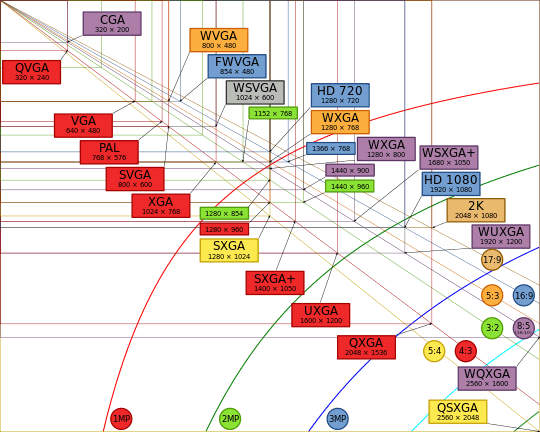16K resolution
The term 16K resolution refers to a display resolution with approximately 16,000 horizontal pixels. The most commonly discussed 16K resolution is 15360 × 8640, which doubles the pixel count of 8K UHD in each dimension, for a total of four times as many pixels.[1] This resolution has 132.7 megapixels, 16 times as many pixels as 4K resolution and 64 times as many pixels as 1080p resolution.
| Resolution | aspect ratio | Megapixels |
|---|---|---|
| 15360 x 4320 | 3.5:1 (32:9) "super ultrawide" | 66.3 |
| 15360 x 6582 | 2.1:1 (21:9) "ultrawide" | 101.1 |
| 15360 × 6400 | 2.4:1 (24:10) | 98.304 |
| 15360 × 6480 | 2.37 (64:27) | 99.5 |
| 15360 × 7680 | 2:1 (18:9) | 118 |
| 15360 × 8640 | 1.7:1 (16:9) | 132.7 |
| 15360 × 9600 | 1.6:1 (16:10) | 147.5 |
| 16200 x 4500 | 3.6 (36:10) | 72.9 |
| 16200 x 6750 | 2.4:1 (24:10) | 109.4 |
| 16200 x 10125 | 1.6:1 (16:10) | 164 |
| 16384 × 8192 | 2:1 (18:9) | 134.217728 |
| 16384 × 10240 | 1.6:1 (16:10) | 167.77216 |
| 16384 x 16384 | 1.0:1 (1:1) | 268.4 |
| 16640 x 4680 | 3.5:1 (32:9) | 77.9 |
| 16640 × 7020 | 2.37 (64:27) | 116.8 |
| 17280 × 4320 | 4.0:1 | 74.65 |
Currently, 16K resolutions can be run using multi-monitor setups with AMD Eyefinity or Nvidia Surround.[2][3]
History
In 2016, AMD announced a target for their future graphics cards to support 16K resolution with a refresh rate of 240 Hz for 'true immersion' in VR.[4][5][6]
Innolux displayed the world's first 100-inch 16K8K (15360 × 8640) display module at Touch Taiwan in August 2018.[7]
Sony introduced a 64-foot-wide by 18-foot-tall commercial 16K display at NAB 2019 that is set to be released in Japan.[8][9] It is made up of 576 modules(360x360p), in a formation of 48 by 12 modules, forming a 17280x4320p screen, with 4:1 aspect ratio.
On June 26, 2019, VESA formally released the DisplayPort 2.0 standard with support for one 16K (15360 × 8640) display @ 60 Hz with 10 bpc (30 bit/px, HDR) RGB/Y′CBCR 4:4:4 color (with DSC).
See also
- Virtual reality
- 8K resolution
- 4K resolution
- High-definition television (HDTV) – digital video formats with resolutions of 1280 × 720 or 1920 × 1080
- Graphics display resolution
References
- Brawn, Alan C. (April 19, 2017). "4K, 8K, 16K – Are You Ready for the Resolution Evolution?". CE Pro. Retrieved August 5, 2017.
- Orland, Kyle (August 3, 2017). "What kind of gaming rig can run at 16K resolution?". ArsTechnica. Retrieved August 5, 2017.
- "Gaming at 16K resolution?? – Holy $h!t". Linus Tech Tips. YouTube. Retrieved October 19, 2017.
- Garreffa, Anthony (2016-07-27). "AMD Radeon Pro graphics card powers 16K display, 15,360×8640". Tweaktown. Retrieved July 27, 2016.
- Garreffa, Anthony (2016-01-15). "AMD's graphics boss says VR needs 16K at 240Hz for 'true immersion'". Tweaktown. Retrieved January 15, 2016.
- Campbell, Mark (2016-01-16). "AMD's Raja Koduri says that we need 16K at 240Hz for "true immersion" in VR". Overclock3D.net. Retrieved January 16, 2016.
- Lokas, Damir (August 23, 2018). "Innolux Premieres World's First 100 Inch 16K Display The Best Vision Ever". DisplayDaily. Retrieved December 23, 2018.
- Waniata, Ryan (2019-04-10). "Sony's massive new MicroLED display stands 17 feet tall and packs 16K resolution". Digital Trends. Retrieved 2019-10-17.
- Dent, Steve (2019-09-13). "Sony's Crystal cinema display supports 16K, but could cost millions". Engadget. Retrieved 2019-12-18.
